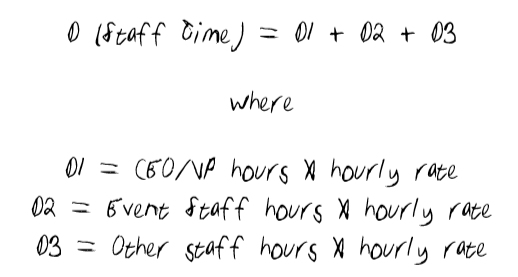
I have long had a love/hate relationship with events. Perhaps it’s because of the inherent risk of running an event (you can potentially lose money), or perhaps it is because I personally prefer one-on-one cultivation events (and really dislike crowds). In any event, it is of utmost importance that you calculate the true cost of the event. (HINT: Your net revenue is not your real net revenue).
Being the numbers guy that I am, here are some quick numbers that need to be factored in:

A: Gross Revenue. This is the very top line — from sponsorship to tickets; from auction to donations; from in-kind gifts to the sale of mulligans.

B: Direct Expenses. This is where all of the expenses go — from venue rental to food; from decor to credit card transaction fees.

- C: Net Revenue: Simply put this is A – B. Unfortunately, this is where most of the reporting stops.
Now comes part two of the equation — the real costs.

- D: Staff Time: This is D1 + D2 + D3
- D1: CEO and VP Fundraising (or equivalent) time. Calculate the number of hours that they put into your event (event day counts) and multiply that by their hourly rate.
- D2: Event Staff. Calculate the number of hours that they put into your event (event day counts) and multiply that by their hourly rate.
- D3: Other Staff. Calculate the number of hours that they put into your event and multiply that by their hourly rate.

E: Trued Net Revenue: This is C – D. This figure now accounts for staff time and is a pretty fair representation of the true viability of the event. I have often asked committees if they would hire a consultant in lieu of staff and the answer was usually a resounding no (don’t worry, readers — I wouldn’t hire a consultant for an event). It boiled down to the committee not valuing the staff members’ time. This has to change.

- F: Cost as a percentage of money raised: This is (B + D) / A. This is usually the simplified way of looking at it.
One could go even further on this analysis and look at the volunteer’s time (G1 + G2):

- G1: Board Volunteer Time: Calculate the number of hours that they put into your event (event day counts) and multiply that by $25 (this is a standard that AFP has used in their calculations in the past).
- G2: Event Volunteer Time: Calculate the number of hours that they put into your event and multiply that by $25 (this is a standard that AFP has used in their calculations in the past).
Why do I separate Board Volunteer Time from Event Volunteer Time? Boards need to be involved in your events — a successful event will have their buy-in.


Now, the Truest Net Revenue (H) is C – (D + G) and the True Cost as a Percentage of Money Raised (J) is (B + D + G) / A. This will also help show the true cost of volunteer’s time — a successful event must have some level of volunteer commitment in order to flourish.
This looks like a lot of alphabet soup, but it truly paints a picture. What you may very well find is that the Trued Net Revenue is actually a loss. (If that’s the case, I would suggest that you re-examine the worthiness of having this event.)
There are a couple of other metrics that may be handy to use:
- Net cash revenue per participant — this helps focus your efforts. Is there a handful of sponsors skewing this revenue upwards (i.e. title sponsors)? That may have some risk down the road if the sponsor moves on and you have a challenge replenishing the title sponsor.
- Net cash revenue per donor (if applicable — some events don’t focus on donations at all). This is a number that should be increasing over time. Perhaps your organization is at $0 right now — look on the bright side — you only have one way to go (up). I would suggest that this is an opportunity to ask for charitable funds (as opposed to sponsorship) at your events. (I believe that sponsorship as a vehicle is not necessarily charitable, rather it is a marketing vehicle.)
Events are a complicated beast. It is our job as fundraising professionals to separate the chaff from the wheat — to focus on what is the best ROI.
Many believe that the ROI for an event (in its simplest form — line C) should never be below 50%. That is probably a good start, but I would go one step further and ensure that line F never falls below 50%.
Hopefully, this handy little tool will enable you to focus on what is a good use of volunteer time, staff time and organizational resources.
Until next week,
L’chaim.




